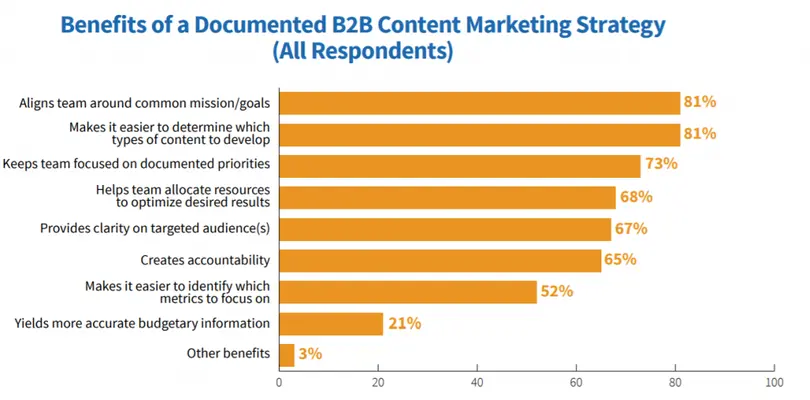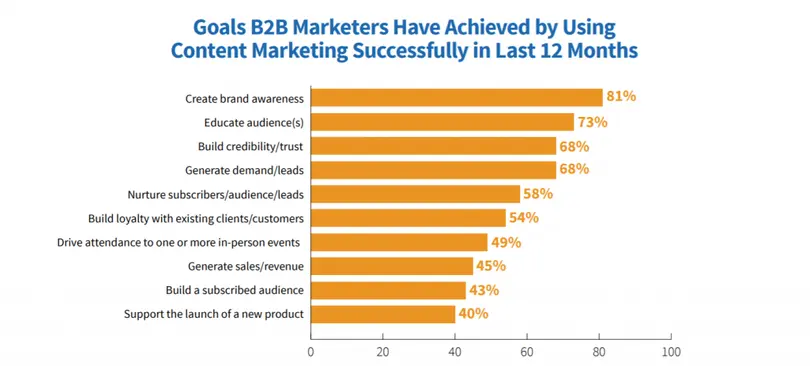Content marketing forms the backbone of any company’s digital marketing initiative. And, the reason is simple—it integrates with all types of marketing tactics like social media, influencers, SEO, and more. No marketing tactic can work without content and, therefore, content is at the heart of all digital marketing.
This is probably why 93% of the most successful B2B marketers are very committed to content marketing. Overall, 67% of B2B marketers and 64% of B2C marketers take content marketing seriously and consider it important.
However, only 39% of B2B marketers and 33% of B2C marketers have a documented content strategy. That is one of the reasons why only a quarter of marketers consider their content marketing to be more than moderately successful.
Having a well-documented content strategy can help align your team members and keep everyone on the same page with regards to goals that you want to achieve.
Here are some of the most important benefits of a content strategy.

Image Source: CMI
An effective content strategy is crucial to the success of your content marketing campaigns.
In this post, we will discuss a content strategy framework that includes the six pillars of an effective content strategy. You can use this as a reference guide for creating your content strategy.
How To Build a Content Strategy Framework | The Ultimate Guide:
1. Goals
The first thing that you need to do when planning a content strategy is to define your goals. You can’t plan a strategy unless you’re clear about what you want to achieve from your initiatives.
Whether you want to get more organic search traffic to your blog or simply engage your audience with interesting social media content, you need to define your goals.
Here are some of the most popular content marketing goals that you can select from.

Image Source: CMI
However, this is just a broad-level list of goals. When planning your content strategy, you need to write much more specific goals. You can use the SMART framework to further define your content marketing goals.
Specific
Goals should not be vague like ”increase brand awareness” or “get more sales conversions.” They should be specific with details of exactly what you want to achieve and how you plan to measure it. So, instead of setting a goal like “increase sales conversions,” set a goal such as “increase sales by x% within Y period of time.”
A specific goal should always have a deadline and a quantifiable metric that can measure success or failure.
Measurable
To make your goals measurable, you need to assign KPIs to track and measure your performance towards that goal. Goals that cannot be tracked and measured don’t solve the purpose, so you should always set measurable goals.
Attainable
Set goals that can be achieved within the time duration that you have set to measure your performance on your set KPIs. If your goals are not attainable, your team may get discouraged.
Realistic
Do not set unrealistic goals that you cannot achieve. Know what you and your team are capable of and set goals that you can realistically achieve.
Time-Bound
Always set a deadline for all your goals, as that is the time period for which you will finally measure your performance.
2. Audience
The next step is to understand and define your target audience. It is even better if you create customer personas for all audience segments that you want to target. Each persona should include their demographics, interests, behaviours, challenges, etc.
77% of the most successful marketers use customer personas for their content marketing.
The better you understand your audience, the more targeted you can make your content. And, that will help you achieve the goals that you have set for your campaign.
3. Content Type/Tone/Voice
This is the step during which you decide exactly what kind of content you want to create. During this stage, you also need to determine your brand voice and tone that you will use for all your content.
Content types may include blog posts, social media content, videos, infographics, or anything else that you want to include in your content strategy.
The second aspect deals with keeping your brand messaging and voice consistent across all of your content and channels. Every successful brand has a clear and distinct brand voice. It is, after you, your brand voice that communicates your brand’s personality.
For example, the beauty brand, Dove, has a very clear and distinct brand voice. All of their messaging is focused on empowering women and promoting inclusion.
Whether you look at their social media posts, TV ads, or any other form of content, their brand voice is consistent. Their messaging is strong and empowering, no matter what type of content they post.
Also, remember that it is not always feasible to create fresh content on a frequent and consistent basis. This is especially true for social media content as for most platforms, you need to post almost daily. So, you should have a content curation strategy in place to ensure that you find and share relevant content, even if you can’t create fresh content every time.
You can either use content curation tools for this purpose or manually search for and share content. If you have a blog, you can sometimes share or update and share old blog posts instead of always creating new ones. This ensures that you post something regularly, without spending too much time on content creation.
4. Distribution Channels
Once you have finalised your content, the next step is to decide the frequency of posting and distribution channels. You should select a mix of distribution channels and not focus on just one or two.
If you already have a blog, then that should be a major focus of your content distribution strategy. Even if you don’t have a blog, you can always guest post on other relevant websites and blogs in your industry.
Social media is an essential part of the content distribution strategies of most marketers. But, you should not overdo it by posting anything and everything on all social platforms. Instead, select 2-3 social media platforms and create content that is best-suited for those platforms.
If you have a B2B firm, then you should include LinkedIn as one of your key content distribution channels.
You can also explore other channels like Quora, Reddit, etc. These are community forums where you can post content by answering questions or participating in discussions.
Select your distribution channels based on where you can find your target audience as these will differ by the type of business you have and your industry.
5. Workflows/Task Management
No matter which distribution channels you select, you need to have an editorial calendar that clearly shows what content needs to be published on which days at what times.
There are numerous tools that you can use to maintain your content calendar and schedule content. For example, Buffer is one tool that lets you bulk upload content and post it at predefined dates and times.
However, to manage all your content, creators, tasks, and projects, it is better to use an all-in-one content marketing tool.
Or, you can opt for a combination of a project management tool like Airtable and a separate scheduling and distribution tool.
No matter which tool or combination of tools you select, ensure that you have complete visibility over all of the tasks and content schedules. Also, ensure that you have an easy way of communicating with all team members and keeping track of task statuses at all times.
6. Performance Tracking and Measurement
No content strategy framework is complete without including performance tracking and measurement. You should always incorporate ways to keep track of your content’s performance as that is how you can measure the success or failure of your initiatives.
As previously stated, all content goals should have a KPI that can be used to measure whether the goal is met or not. So, you set goals, execute your strategy, measure performance, and improve your future strategy. That is how you need to close the loop.
So, have a plan in place to measure your content’s performance and use these insights to fuel your future strategy.
You should also use analytics tools to analyse the performance of your content and get detailed insights. For content posted on your website, a simple tool like Google Analytics should provide enough insights into which pages are doing well and which aren’t. For social media content, you can use each platform’s built-in analytics tool to find out which posts performed well.
Conclusion
If you want to run successful content marketing campaigns, you need to have a solid content strategy in place. And, this content strategy framework guide will help you develop a winning content strategy with ease.
Use this post as a guide for designing a content strategy framework that you can use for different content marketing campaigns. All you need to do is modify one or more of the six elements discussed above and customise your strategy for each campaign.
So, leverage this content strategy guide and run successful content marketing campaigns.




